Hyperpolarisation: Probe Development & Clinical Application
Oral
Molecular Imaging
Monday, 18 June 2018
| S04 |
16:15 - 18:15 |
Moderators: Kerstin Timm, Jan Henrik Ardenkjśr-Larsen |
16:15
|
0272.
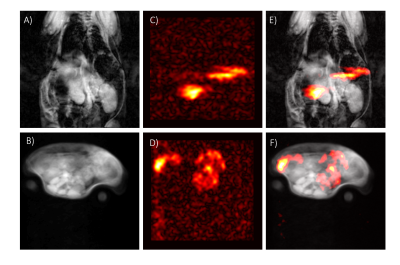 |
 In vivo Imaging of Hyperpolarized Silicon-29 Nanoparticles In vivo Imaging of Hyperpolarized Silicon-29 Nanoparticles
Grzegorz Kwiatkowski, Jonas Steinhauser, Patrick Wespi, Matthias Ernst, Sebastian Kozerke
Hyperpolarized silicon particles exhibit very long T 1 relaxation at room temperature, making them favourable as novel imaging MR probes. It has recently been shown that silicon particles in the nanometer size range can be efficiently polarized and image even after 4 hours upon transfer of the sample to the imaging system. The objective of the present work was to demonstrate the imaging capability of surface functionalized hyperpolarized nanometer size silicon particles in an experimental in-vivo setting.
|
16:27
|
0273.
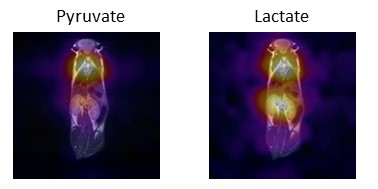 |
 An in vivo metabolic imaging study of myopathy in transgenic mice using C-13 hyperpolarized pyruvate generated by ParaHydrogen An in vivo metabolic imaging study of myopathy in transgenic mice using C-13 hyperpolarized pyruvate generated by ParaHydrogen
Francesca Reineri, Eleonora Cavallari, Carla Carrera, Silvio Aime
Hyperpolarized [1-13C]pyruvate has been widely exploited for the in vivo investigation of metabolic processes under normal and diseased conditions. The possibility to obtain it using the cost effective and fast PHIP (ParaHydrogen Induced Polarization) method would allow a widespread application of this powerful diagnostic tool to pre-clinical research and would pave the way to future clinical translation. Here we show the first in vivo studies carried out on genetically modified mice using [1-13C]pyruvate obtained by means of the PHIP-SAH (PHIP-Side Arm Hydrogenation) method. The results obtained from PHIP-SAH hyperpolarized pyruvate are consistent with the pathologic state of the heart tissue.
|
16:39
|
0274.
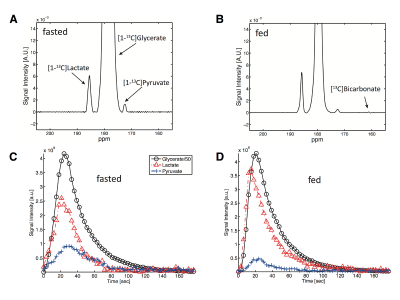 |
 Hyperpolarized sodium [1-13C]glycerate as a probe for assessing glycolysis in vivo Hyperpolarized sodium [1-13C]glycerate as a probe for assessing glycolysis in vivo
Jae Mo Park, Marvin Wu, Thomas Hever, Xiaodong Wen, Daniel Spielman, Kelvin Billingsley
We describe the synthesis, development and in vivo application of sodium [1-13C]glycerate as a novel probe for evaluating glycolysis using hyperpolarized 13C MRS. [13C]glycerate displayed a high level of polarization and long spin-lattice relaxation time. In vivo spectroscopic studies with hyperpolarized [13C]glycerate in rat liver furnished metabolic products, pyruvate and lactate, originating from glycolysis. The levels of production and relative intensities of these metabolites were directly correlated with the induced glycolytic state (fasted versus fed). This work establishes hyperpolarized [13C]glycerate as a novel agent for clinically relevant 13C MRS studies of energy metabolism and further provides opportunities for evaluating intracellular redox states in biochemical investigations.
|
16:51
 |
0275.
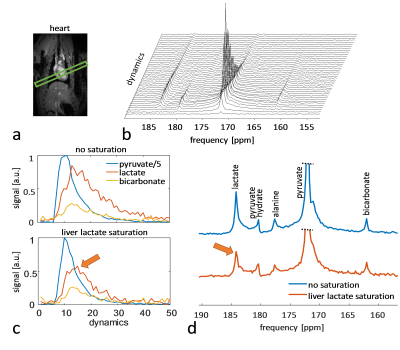 |
 Overestimation of cardiac lactate production due to liver metabolism of hyperpolarized [1-13C] pyruvate Overestimation of cardiac lactate production due to liver metabolism of hyperpolarized [1-13C] pyruvate
Patrick Wespi, Jonas Steinhauser, Grzegorz Kwiatkowski , Sebastian Kozerke
Spectroscopy is widely used in hyperpolarized metabolic experiments due to its simplicity and robustness. In this work, it is shown that with spectroscopic acquisition in rat hearts, the cardiac lactate production is overestimated due to liver metabolism of [1-13] pyruvate. It is demonstrated that this overestimation can be addressed using spatially resolved data.
|
17:03
|
0276.
 |
 Hyperpolarized 13C Metabolic Imaging of Human Hypertrophic Cardiomyopathy Hyperpolarized 13C Metabolic Imaging of Human Hypertrophic Cardiomyopathy
Angus Lau, Albert Chen, Justin Lau, Benjamin Geraghty, William Perks, Idan Roifman, Graham Wright, Kim Connelly, Charles Cunningham
The feasibility of using hyperpolarized 13C to interrogate in vivo human metabolism in the healthy heart has recently been demonstrated. In this abstract we demonstrate the feasibility of using hyperpolarized 13C imaging to detect metabolic alterations in human hypertrophic cardiomyopathy. Results show significantly elevated 13C-bicarbonate-to-pyruvate ratio near the apex of the heart, corresponding to the known location of disease. The 13C-bicarbonate images also show a different spatial distribution from those observed in healthy volunteers. These results show good prospects for imaging the altered cardiac energetics in the diseased heart using this technology.
|
17:15
 |
0277.
 |
 Imaging the healthy human brain with hyperpolarized [1-13C] pyruvate Imaging the healthy human brain with hyperpolarized [1-13C] pyruvate
James Grist, Mary McLean, Surrin Deen, Frank Riemer, Charlotte Daniels, Andrew Gill, Fulvio Zaccagna, Rolf Schulte, Sarah Hilborne, Jackie Mason, James McKay, Arnaud Comment, Anita Chhabra, Vicky Fernandes, Hannah Loveday, Marie-Christine Laurent, Ilse Patterson, Ronnie Hernandez, Rhys Slough, Tomasz Matys, Ian Wilkinson, Bristi Basu, Claire Trumper, Damian Tyler, David Lomas, Martin Graves, Alasdair Coles, Kevin Brindle, Ferdia Gallagher
Initial results from imaging the healthy human brain with [1-13C] pyruvate are presented. Labelled lactate and bicarbonate formation are seen, as well as differences in gray and white matter perfusion.
|
17:27
|
0278.
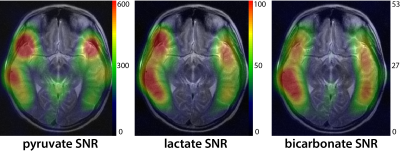 |
 Hyperpolarized Carbon-13 Metabolic Imaging of Pediatric Patients with Brain Tumors: Initial Experience Hyperpolarized Carbon-13 Metabolic Imaging of Pediatric Patients with Brain Tumors: Initial Experience
Ilwoo Park, Adam Autry, Yiran Chen, Jeremy Gordon, Lucas Carvajal, Hsin-Yu Chen, Robert Bok, Mark Van Criekinge, James Slater, Cassie Kline-Nunnally, Peder Larson, Daniel Vigneron, Janine Lupo, Duan Xu, Sabine Mueller
This study applied hyperpolarized 13C metabolic imaging in pediatric populations for the first time to our knowledge. Dynamic 13C data were acquired following injection of hyperpolarized [1-13C]pyruvate in the first 3 pediatric patients with brain tumors as part of an ongoing trial (PNOC011,NCT02947373). No adverse effects were observed for these 3 patients. Pyruvate, lactate and bicarbonate signals with high SNR were detected in the pediatric brain. These preliminary results demonstrated the feasibility of using HP [1-13C]pyruvate for assessing in vivo metabolism from pediatric patients with brain tumors and support ongoing investigation of this technology in pediatric patients.
|
17:39
|
0279.
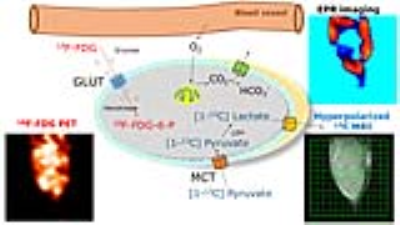 |
 Multimodal Characterization of In Vivo Metabolic Activities with Hyperpolarized 13C MRI, 18F-FDG PET, and EPR Imaging in Pancreatic Ductal Adenocarcinoma Tumors Multimodal Characterization of In Vivo Metabolic Activities with Hyperpolarized 13C MRI, 18F-FDG PET, and EPR Imaging in Pancreatic Ductal Adenocarcinoma Tumors
Kazutoshi Yamamoto, Tomohiro Seki, Shun Kishimoto, Nallathamby Devasahayam, Nobu Oshima, Stephen Adler, Elaine Jagoda, Keita Saito, Jeffrey Brender, Peter Choyke, James Mitchell, Murali Krishna
Profiling the metabolic and physiologic phenotypes of tumors has become important in treatment planning and response monitoring. Here, multimodal imaging methods, including hyperpolarized 13C MRI, 18F-FDG PET, and EPRI imaging, were used to profile the metabolic and physiologic features of human pancreatic ductal adenocarcinoma (PDAC) tumors, Hs766t, MiaPaCa-2, and SU.86.86. PDACs have some of the worst prognoses of all cancers. Experimental results have demonstrated, for the first time, the feasibility and advantages of multimodal metabolic and physiologic assessment of xenograft tumors. This multimodal imaging approach will complement tumor characterization, lead to better prognostics, and earlier response monitoring in cancer treatment.
|
17:51
 |
0280.
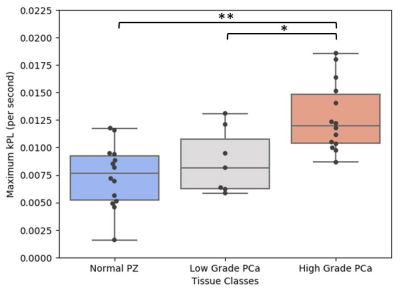 |
 The Rate of Hyperpolarized [1-13C] Pyruvate to [1-13C] Lactate Conversion Distinguishes High-Grade Prostate Cancer from Low-Grade Prostate Cancer and Normal Peripheral Zone Tissue in Patients The Rate of Hyperpolarized [1-13C] Pyruvate to [1-13C] Lactate Conversion Distinguishes High-Grade Prostate Cancer from Low-Grade Prostate Cancer and Normal Peripheral Zone Tissue in Patients
Natalie Korn, Peder Larson, Hsin-Yu Chen, Jeremy Gordon, Robert Bok, Mark VanCriekinge, James Slater, Rahul Aggarwal, Matthew Cooperberg, Romelyn Delos Santos, Justin Delos Santos, Jeffry Simko, Susan Noworolski, Daniel Vigneron, John Kurhanewicz
The accurate discrimination of aggressive from indolent prostate cancer at diagnosis remains a pressing clinical need. High spatial and temporal resolution 3D dynamic hyperpolarized 13C MRSI has previously demonstrated the ability to correlate hyperpolarized (HP) [1-13C]pyruvate to [1-13C]lactate conversion, kPL, with cancer grade in murine models. This initial analysis of patients studies enrolled in a phase II pre-prostatectomy clinical trial demonstrated for the first time that maxmium kPL (kPLmax) is significantly elevated in high-grade prostate cancer versus both normal (p=0.0003) and low-grade disease (p=0.034).
|
18:03
|
0281.
 |
Detection of D-amino acid oxidase using hyperpolarized molecular probes
Video Permission Withheld
Alice Radaelli, Hikari Yoshihara, Rolf Gruetter
D-amino acid oxidase (DAO) is an enzyme that catalyzes the degradation of D-amino acids in the body. Here, we explored the possibility of detecting D-amino acid oxidase activity by monitoring its metabolism in the rat kidney after a bolus injection of hyperpolarized D-[1-13C]alanine. Our data show that D-alanine is readily converted to lactate only when the DAO enzyme is not inhibited, indicating that the observed metabolism is that of DAO.
|
|













